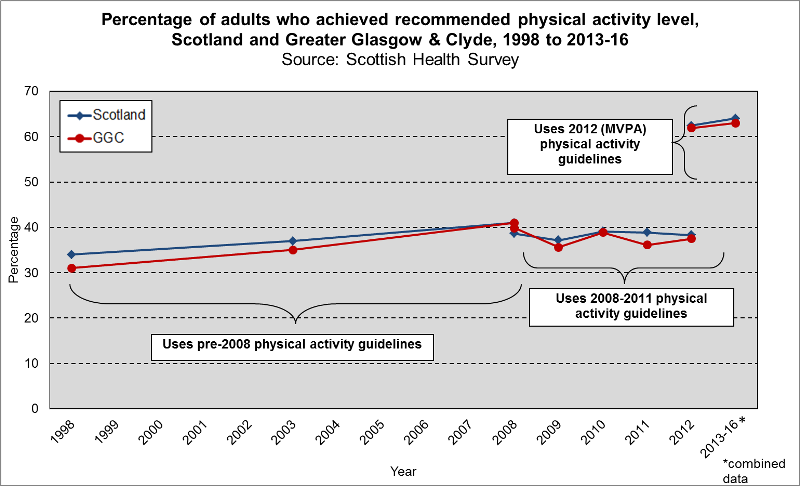Greater Glasgow and Clyde
Trend in adults meeting recommended weekly physical activity levels in Scotland and Greater Glasgow and Clyde
 In the ten years between 1998 and 2008, the proportion of the adult population meeting the recommended physical activity guidelines in Greater Glasgow & Clyde rose from 31% in 1998 to 41% in 2008.
In the ten years between 1998 and 2008, the proportion of the adult population meeting the recommended physical activity guidelines in Greater Glasgow & Clyde rose from 31% in 1998 to 41% in 2008.
Between 2008 and 2012, there was little change in the percentage meeting the recommended physical activity levels.
The 2012 physical activity guidelines (see Notes below) are significantly different to the previous guidelines and are not comparable. Using these guidelines, 62% of adults in Scotland and Greater Glasgow & Clyde met the recommended physical activity guidelines in 2012, however, using the 2008-2011 guidelines only 38% of adults in Scotland and 37% of adults in Greater Glasgow & Clyde met the recommended levels in the same year.
Under these guidelines, the percentage of those in Greater Glasgow & Clyde meeting the recommended amount of physical activity rose slightly. Across all time periods examined, a similar pattern has been seen across Scotland as a whole.
Notes
The government-recommended physical activity guidelines for adults changed in 2008 and again in 2012. The different physical activity guidelines are given below:
pre-2008: a minimum of 30 minutes moderate or vigorous physical activity on at least five days a week, which can be made up of 15 minute bouts of exercise.
2008-2011: a minimum of 30 minutes moderate or vigorous physical activity on at least five days a week, which can be made up of 10 minute bouts of exercise.
2012 (MVPA): a minimum of 150 minutes of moderate activity or 75 minutes of vigorous activity per week which can be made up of 10 minute bouts of exercise.
Source: Scottish Health Survey 2013 to 2016.
The information shown above is based on a survey sample, i.e. based on only a subset of people in each health board. As with all analysis from survey data, there is a degree of uncertainty around how estimates from a subset of people accurately reflect the data from all individuals.
